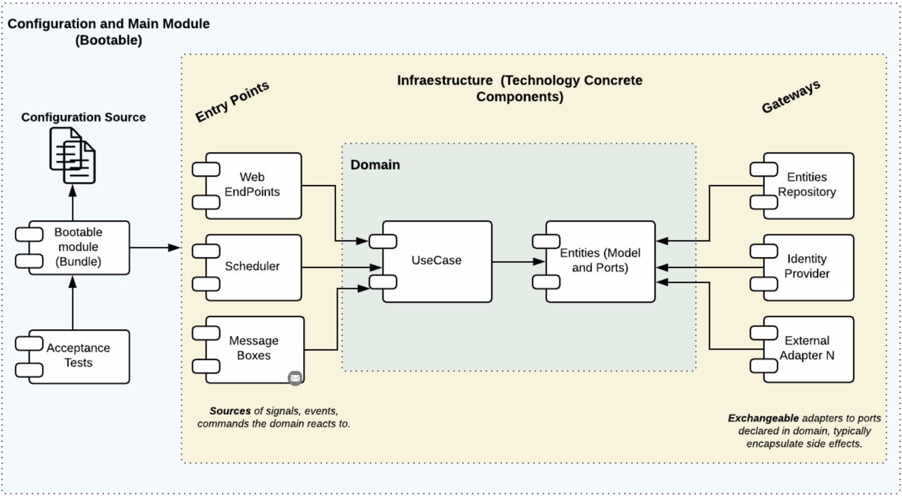Overview
Scaffolding of Clean Architecture

The purpose of Scaffold Clean Architecture Gradle Plugin is to provide a way to create a project with a clean architecture structure, with the necessary dependencies and configurations to start developing a project with the Clean Architecture principles.
We have adopted the Clean Architecture principles proposed by Robert C. Martin, which are based on the separation of concerns and the dependency rule, which states that the dependencies must always point inwards, from the outer layers to the inner layers.
The below image shows the layers of the Clean Architecture applied, this is built on a multimodule gradle project structure.
Layers
Domain
We have the Domain layer, which is the most internal layer of the architecture, it belongs to the domain layer and encapsulates the logic and business rules through domain models and use cases. This should define the ports as interfaces (ports) and the domain models and use cases as classes.
This layer is composed by two gradle modules called model and usecase.
model module contains the domain models and entities, which are the representation of the business rules and logic. It
also defines the ports (interfaces) that will be used in the usecase module.
usecase module contains the use cases of the system, defines the application logic and reacts to invocations from
the entry points modules, orchestrating the flows towards the domain module and using the defined ports.
Infrastructure
In this layer we will have the detailed technologies and implementations of the ports defined in the domain layer. This
layer is composed by three group of modules called entry-points, driven-adapters and helpers.
entry-poits modules contains the entry points of the application or the start of the business flows. These can be REST
controllers, Kafka consumers, etc.
driven-adapters modules represent external implementations to our system, such as connections to rest services, soap,
databases, reading flat files, and in particular any source and data source with which we must interact.
helpers modules contains general utilities for the Driven Adapters and Entry Points.
Application
This module is the most external of the architecture, it is responsible for assembling the different modules, resolving dependencies and creating the beans of the use cases automatically, injecting into these concrete instances of the declared dependencies. It also starts the application (it is the only module in the project where we will find the function "public static void main(String[] args)").
Features
Our scaffold is able to generate imperative and reactive projects. The imperative project is based on Spring Boot and the reactive project is based on Spring WebFlux.
Project Reactor
Reactor is a highly optimized reactive library for building efficient, non-blocking applications on the JVM based on the Reactive Streams Specification. Reactor based applications can sustain very high throughput message rates and operate with a very low memory footprint, making it suitable for building efficient event-driven applications using the microservices architecture.
Reactor implements two publishers Flux<T> and Mono<T>, both of which support non-blocking back-pressure. This enables exchange of data between threads with well-defined memory usage, avoiding unnecessary intermediate buffering or blocking.
Reactive Commons
Reactive Commons is a reactive API for asynchronous message driven communication based on Reactor. Reactive Commons API enables messages to be published over a event bus like RabbitMQ and consumed using functional APIs with non-blocking back-pressure and low overheads. It enables applications using Reactor to use RabbitMQ as a message bus, integrating it with other systems to provide an end-to-end reactive system.
When we talk about asynchronous message driven communication, we can use several semantic ways to use the term " message". So, we can talk about Events, Commands and Queries.
Secrets Manager
Our adapters can be configured to use the Secrets Manager to retrieve the secrets needed to connect to the external systems. This way, the secrets are not stored in the code, but are retrieved from the Secrets Manager or another service at runtime.
You can know more about the Secrets Manager utility here.
Versioning
Reactive Commons uses Semantic Versioning Specification
Reactive Commons uses a MAJOR.MINOR.PATCH scheme, whereby an increment in:
MAJOR version when you make incompatible API changes,
MINOR version when you add functionality in a backwards compatible manner, and
PATCH version when you make backwards compatible bug fixes. Additional labels for pre-release and build metadata are available as extensions to the MAJOR.MINOR.PATCH format. == New & Noteworthy
Analytics
You can help the Contributors Team to prioritize features and improvements by permitting the Contributors team to send gradle tasks usage statistics to Analytics Server. The Contributors Team collect usage statistics unless you explicitly opt in off.
Due to the user input limitations to gradle task, when running any plugin task you will be notified about the analytics recollection, and you have the possibility to disable this recollection. If you enable or disable analytics explicitly, future task executions will not notify you.
To explicitly enable analytics and avoid the notification message
gradle analytics --enabled true
# gradle a --enabled true
To disable analytics
gradle analytics --enabled false
# gradle a --enabled false
What is collected?
Usage analytics include the commands and selected flags for each execution. Usage analytics may include the following information:
- Your operating system (macOS, Linux distribution, Windows) and its version.
- Java vendor name and version.
- Java specification and runtime versions.
- Plugin version.
- Project language
java - Task name that was run.
- Workspace information like language, user that is running the task.
- For generate use case, generate model, generate helper and delete module tasks, the name will be sent.
- For all tasks, the type and name, the time it took to run the task, and project type (reactive, imperative).
Whats Next?
Read more About Clean Architecture
We also have an Elixir variant
How can I help?
Review the issues, we hear new ideas. Read more Contributing
